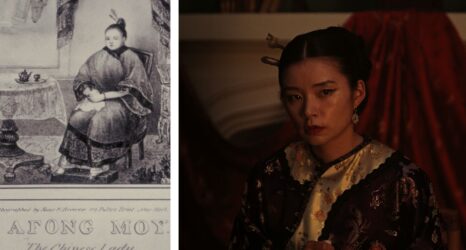Translating dystopian texts to the screen is tricky business, as such texts rely so much on the reader’s perception of what a truly dystopian society would look and feel like. To some, the visuals of The Giver might seem ideal: cookie-cutter houses filled with sparse, functional, IKEA-like furnishings and a society that also has a straight-lined, minimalist, monotonous IKEA vibe, down to the clothing worn and the bicycles ridden.
As we learn in the opening narration, the people of this society “lived in a world where differences weren’t allowed”—where, in order to create “equality,” the society “did away with color, race, religion and created sameness.” The society also does away with memories and emotions in order to promote sameness and, as the narrative implies prevent people from making the wrong choices. As noted by the Chief Elder (Meryl Streep), “When people have the freedom to choose, they choose wrong … every single time.” Instead of individual memories, a single person is assigned to be the memory keeper; this memory keeper then “gives” the shared memories to the new memory keeper, or the “receiver of memory.” In the film, Jeff Bridges plays the role of the Giver and young Jonas (Brenton Thwaites) the Receiver. In a sense, this keeper of memory is like a living library–a human storehouse for all the memories from the past.
In this new society of sameness, rules are named as the “building blocks” of equality. But, as the narrative reveals, “sameness” is not the same thing as “equality.” The people of the society follow the same rules, see the world in the same colors (visually captured by much of the film being in black and white), ride the same bicycles and live in the same style of houses. However, though they talk, dress and travel the same, they are not equal. Certain roles in the society hold more power and prestige, including being the receiver of memory. This role is necessary, it is suggested, in order to store the painful memories of past war, famine, government corruption, forced separation of families, animal slaughter and so on. Receiving these memories causes pain, but other memories–of snow, holidays, music, dancing and so on–bring great joy. Such emotions and the passions they stir, it is suggested, is what this new society wishes to avoid. As indicated by the Chief Elder, love can turn, as can passion, and allowing such emotions would open up their world to the possibility of “wrong choices.”
And herein is the “sameness” that the people of the society share equally: the lack of choice. The citizens do not choose what their house will look like, what role they will play, or even how or what they will feel (they are given injections each morning to dull emotion). Jonas does not choose to take over as receiver of memory; rather, he is assigned to this position, as all citizens are assigned roles when they enter adulthood. This lack of choice is what is deemed as making their world successful and free of war, famine and other atrocities.
From a feminist perspective, where the depiction of such a choiceless society becomes especially intriguing is in the “release to elsewhere”–death by injection that calls to mind the debate over “pro-choice” verses “pro-life.” While the polarity of these terms does not do justice to the full spectrum of views on reproductive rights in the real world, it is the way the rhetoric surrounding the topic is most often framed–as, like the film’s visuals, a black-and-white issue.
On one level, the condemnation of “release to elsewhere,” in which “unqualified” babies and older people are “released,” indicates that humans should have a choice regarding when to end life. Such a condemnation bolsters pro-choice arguments. However, when the current receiver of memory (Bridges) notes that the claim that murder has been eradicated is false—that “they hadn’t eliminated murder … they just called it by a different name”—the narrative brings to mind the “abortion is murder” rhetoric used by pro-lifers. Granted, the film never condemns abortion or family planning. If anything, we are left to assume the society must rely on contraception in order to stick to the strict precepts of two children per family unit. Nonetheless, the resonance of opposing views remains: Is this society “pro-life,” as it has condemned war and manages its resources so no one starves to death, no one is unemployed, no one is homeless? Or is it “pro-choice” because, in order to equitably share limited resources, the choice is made to limit the number of children to two per family and to “release” some babies and all humans once they reach a certain age?
Though what it means to be pro-life verses pro-choice are not a key focus of the narrative itself, the exploration of what it means to have free choice, and what it means to be pro-life, resonated for me as a feminist viewer. On one hand, the depiction of “release to elsewhere”–especially of one of the unqualified babies, who is given a lethal injection and then dropped down a chute—could surely be used as grist for organizations who are deemed pro-life. (Especially given that in real life, abortion foes often use jarring images of fetuses to further their claim that abortion is murder, despite the fact that such images misrepresent the reality of abortion.) On the other hand, the suggestion that birth control and family planning are necessary in a world of limited resources are in keeping with pro-choice sentiments. Further, the focus on “unqualified” babies who are at least several months old–not on embryos, fetuses, or zygotes (what those on the “pro-life” side often call “life”)– indicates that this “release” is NOT the same thing as abortion. (Thus, the story is much different from the one told by the likes of Rand Paul—the horror at ending a life is not focused on the contents of a pregnant woman’s uterus, but on a functioning, breathing, fully formed human baby.)
That the images of “realease to elsewhere” are juxtaposed with murderous images–the slaughter of elephants, the killing of innocents by military forces–could be interpreted as furthering the pro-life claim that the taking of “life” is murder . However, the suggestion that murder of the past (war, genocide, etc) has been supplanted with a different kind of murder which is no better emphasizes the hypocrisy at the heart of the pro-life stance: that those who condemn abortion as “murder” also call for the killing of abortion providers and/or support war, resist gun control, and fail to condemn genocide. The quote the current receiver says to Jonas about murder not being eliminated just renamed is applicable here: Pro-lifers do not eliminate what they call murder (abortion and contraception); rather, they call reproductive choice “murderous” and name what they do (such as killing providers like Dr. Tiller) as protecting innocent lives. In doing so, however, they perpetuate the lack of choice that perpetuates so many of the murdering forces in our society: poverty, criminalization, the military machine.
In the film, Jonas is inspired to attempt escape from this choice-less society, in part via his interaction with baby Gabe, an “unqualified” child who is scheduled to be “released.” Jonas is no pro-lifer in the sense of the way organizations like God’s Army use the term;- no, he is truly “pro-life” because he is for choice. This strand of the narrative emphasizes that freedom of choice is what allows us to be fully human. Though this society believes“when people have the freedom to choose, they choose wrong … every single time,” Jonas proves that people do not choose wrong every time. More importantly, he proves that the power to choose is what makes us most fully human, most open to love, to change, to hope.
Given that the freedom to choose is currently being chipped away at an alarming rate in the United States, The Giver provides a very important reminder that freedom of choice is what makes us human. Let’s hope the tide will turn and we will not all end up in IKEA-kitted prison-homes with drones monitoring our every move. Let’s hope we soon remember the importance of valuing and honoring free will. The film version of The Giver does not pack the same punch of the novel, but it does deliver a very important message: Who wants to live in a society of sameness that is devoid of choice, of love, of what it truly means to be human?Give yourself a gift and see the film (or read the book) and be reminded of the beauty of choice.





